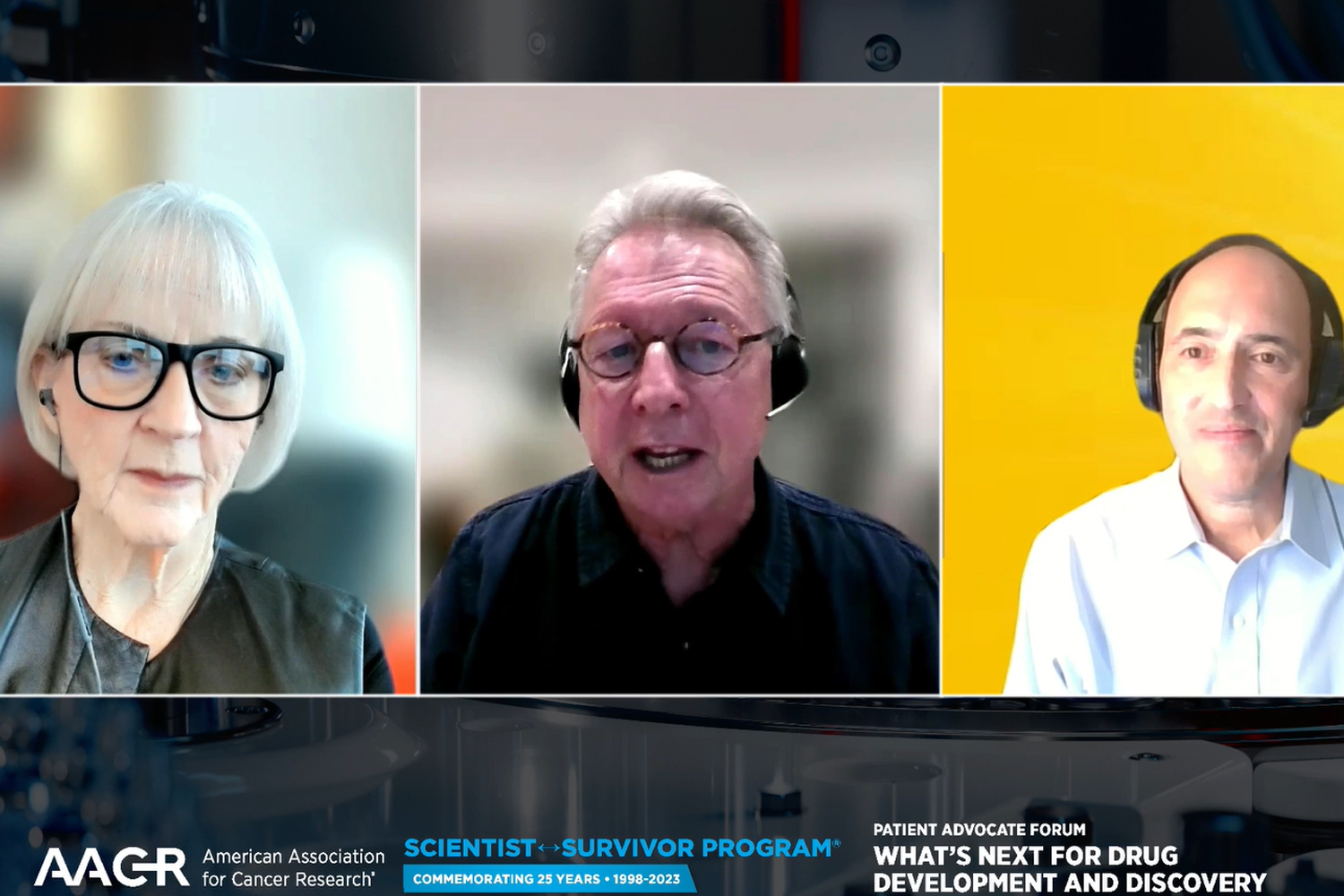AS MEDICINE EMBRACES individualized treatments, oncologists need more options to address the wide variety of patients and cancer types. However, the journey from an idea in the lab to an approved drug that effectively targets cancer typically takes more than a decade—and is most often cut short in a failed trial. So how can scientists speed up that process and make it more efficient?
The latest Virtual Patient Advocate Forum held by the American Association for Cancer Research (AACR) explored different potential answers to that question. (The AACR also publishes Cancer Today.) During the Sept. 12 forum, titled “What’s Next for Drug Development and Discovery?” experts discussed current challenges to drug discovery and how they plan to overcome them.
“Everything depends on us developing these drugs really quickly,” said Anna Barker, chief strategy officer of the Ellison Institute for Transformative Medicine in Los Angeles and the forum moderator. “That’s difficult because everything takes a long time in drug discovery and development.”
The forum highlighted the long and challenging path to developing a new cancer drug. For every 5,000 to 10,000 compounds studied, only one drug will be approved by the Food and Drug Administration. On average, that process takes 11 years and costs $4 billion. Only 5.3% of oncology drugs that enter clinical trials are approved. “It does take a long time to develop drugs, it’s very expensive, and it’s often unsuccessful,” said Paul Workman, a professor at the Institute of Cancer Research in London.
The experts said some of the challenges that keep the success rate low include drug resistance and undruggable targets. One target that, until recently, was thought to be undruggable by targeted treatments is the RAS gene family. RAS mutations—which come in three forms: KRAS, NRAS and HRAS—lead to cancer cell growth, migration and survival. They are commonly found in a variety of diseases, including bladder, colorectal, lung, pancreatic and thyroid cancers.
While other drugs target mutations by binding to the protein in question to stop cell growth, KRAS proved especially difficult to target, according to Frank McCormick, a professor at the Helen Diller Family Comprehensive Cancer Center at the University of California, San Francisco, and the scientific project leader of the National Cancer Institute’s RAS Initiative. Its smooth surface offers no deep pockets to which chemicals can bind, leaving scientists to believe RAS-mutated cancers were undruggable.
Then in 2013, researchers discovered a compound capable of binding to a common KRAS mutation called G12C. Since then, two G12C inhibitors have been approved, but they have not produced a significant survival benefit compared with chemotherapy. However, a “substantial pipeline of drugs” is now in the works, according to McCormick. “We’re off to a good start,” he said. “We have a long way to go, but we have some very clear directions as to how to make better drugs and more efficacious drugs.”
The experts identified several ways that researchers expect to speed up the drug discovery process and improve efficiency. One method involves emphasizing the importance of cancer biomarkers, which are genes, proteins or other substances that characterize a specific tumor’s makeup. These biomarkers are often the target for cancer therapies.
Workman said identifying patients’ biomarkers before launching a clinical trial is key to effectively testing drugs. He described a trial he worked on where some participants responded to a new therapy, while others did not. They then had their DNA sequenced, and researchers discovered the people who responded to the drug had an EGFR mutation, while those who did not exhibit a response lacked the mutation. Workman noted trials that use preselection biomarkers have double the success of those that do not. Furthermore, from 2016 to 2020, 85% of approved oncology drugs went through trials where participants were selected based on their biomarkers.
Another way to improve the process is using artificial intelligence (AI) to accelerate research. Barker noted past research has collected a wealth of data, and now AI can help synthesize that data into useful information. “We’re entering a period now where understanding of cancer will be, in large measure, driven by data,” she said.
Workman highlighted AlphaFold, an AI program that can accurately predict the structure of different proteins produced by cancer cells. With knowledge of the structure, researchers can develop drugs to bind to those proteins.
Workman also expressed excitement about using a “digital twin”—a type of AI that builds a mathematical database model and then conducts experiments within that model instead of performing them in real life on an animal or a tissue sample. Having the program predict results can avoid time wasted on unsuccessful experiments. “It’s a super sophisticated way of computationally predicting the results of an experiment, and then that can be taken to patients,” he said.
“I have no doubt that AI will eventually impact all stages of the drug discovery pathway and routine clinical use,” Workman said.
All of these advances in speed and efficiency are critical to the end users of these drugs: cancer patients. “As a patient, we want to see results that are moving forward, that are giving us more options,” said Howard Brown, a two-time stage IV cancer survivor who works both as a patient advocate and as an internet software entrepreneur.
Brown, who has participated in two clinical trials of cancer drugs, emphasized that, as participants, patients play a key role in the drug development process. Brown said in order for people with cancer to effectively participate in trials, drug developers need to simplify the enrollment process, get patient advocates involved in trial design, have trial participants reflect real-world diversity, and consider a drug’s potential long-term side effects.
“We’re doing good, but we have to do better, and we have to have more sense of urgency,” Brown said.
Cancer Today magazine is free to cancer patients, survivors and caregivers who live in the U.S. Subscribe here to receive four issues per year.





